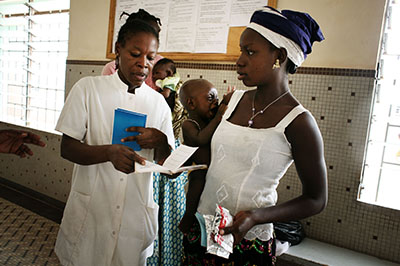 The success of the Plumpy'Nut fighting malnutrition
The success of the Plumpy'Nut fighting malnutrition The first therapeutic food to fight malnutrition
Plumpy'Nut is a therapeutic food tasting and feeling a lot like peanut butter. It was designed by two French scientists. It is very simple to administer and seems to stands for an efficient response to malnutrition.
From tasty yoghurt to the "poor man's Nutella"
Michel Lescanne is deeply fond of his native Normandy. A professional agriculture engineer, he is the son of the creator of the famous French yoghurt brand Mamie Nova. He could have followed in his father's footsteps. But after having travelled in Senegal, he decided to work in research for humanitarian nutrition. He founded the company Nutriset in 1986. Ten years later, he designed with physician André Briend the first ready-to-use nutritive paste to fight severe malnutrition: Plumpy’Nut. The milk paste tastes like peanut butter and is improved with vitamins and minerals.
This "poor man's Nutella", as André Briend called the product informally, was first used on a national scale in 1998 by the NPO Doctors without borders to fight famine in Southern Sudan. But Plumpy'Nut really proved itself in 2005 during the food crisis in Niger: it allowed to treat over 60,000 children. Since 2007, international organisations such as the WHO, Unicef or the UN recommend the use of this ready-to-use therapeutic food.
Food with more benefits than therapeutic milk
In terms of nutritional contents and energy value, there are not many differences between therapeutic milk and Plumpy'Nut. But the last has several advantages.
First, it is easy to administer. Plumpy’Nut doesn't need any preparation. On the contrary, therapeutic milk is a powder you need to add to drinking water according to a precise dosage with only a few hours of conservation possible. The calories ratio of the Nutriset paste is another asset: 500 calories per pack is a significant amount of energy in a small volume. Last but not least, children love the sweet taste of the Plumpy'Nut, which allows to tackle a frequent symptom in acute malnutrition: the loss of appetite.
The limits of the supernut
In spite of undeniable qualities, Plumpy'Nut has raised critics from experts in nutrition and development. Doctors without borders and the Unicef have spread their use to the treatment of moderate malnutrition, not only the acute one. However, this type of food may not be appropriate to treat deficiencies linked to this type of malnutrition.
Another big issue: the price of Plumpy'Nut is almost as high as... Nutella. This is due to a patent protecting the innovation, the low automation of African factories and the actual costs of raw materials. These obstacles limit the production in countries where Plumpy'Nut is most needed.
A new objective: to prevent malnutrition
Critics were useful. The SMB Nutriset launched the programme “Plumpy Field” in 2005 and looks to develop the manufacture of Plumpy'Nut in the countries of distribution. The objective is to lower the share of production in the Normandy factory from 70% to 50%. In parallel, Nutriset has launched a range of particular nutritional pastas: they have a protein and iron content more adapted to an audience suffering from moderate malnutrition.
Today, the company enters the era of diversification. In late 2014, it deployed Tweed, a research lab on new food to tackle malnutrition. Its first creation is a traditional Burkinabese dish that will be sold in a social and sustainable retailer in Ouagadougou.
Picture: ©Michaël Zumstein/Agence Vu

